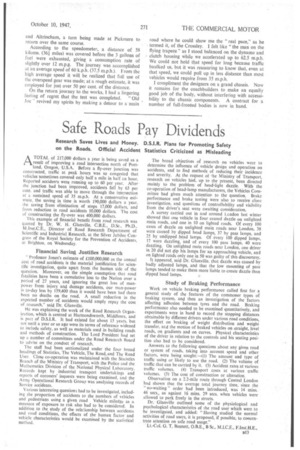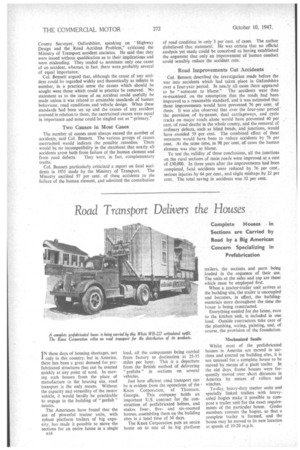Safe Roads Pay Dividends
Page 47

Page 48

If you've noticed an error in this article please click here to report it so we can fix it.
Research Saves Lives and Money. D.S.I.R. Plans for Promoting Safety on the Roads. Official Accident Statistics Criticized as Misleading
ATOTAL of 217,000 dollars a year is being saved as a result of improving a road intersection north of Portland, Oregon, U.S.A. Before a fly-over junction was constructed, traffic at peak hours was so congested that vehicles-Sometimes covered only half a mile in half an hour. Reported accidents were running up to 60 per year. After • the junction had been improved, accidents fell by 63 per cent. and traffic was able to move through the intersection at a sustained speed of 35 m.p.h. At a conservative estimate, the saving in time is worth 190,000 dollars a year, the saving from elimination of stops 17,000 dollars, and from reduction in road accidents 10,000 dollars. The cost of constructing the fly-over was 400,000 dollars.
This example of financial benefit from road research was quoted by Dr. W. H. Glanville, C.B.E., D.Sc., Ph.D.. Minst.C.E.,• Director of Road Research Department of Scientific and Industrial Research. at the Silver Jubilee Congress of the Royal Society for the Prevention of Accidents, at Brighton, on Wednesday.
Financial Saving Justifies Research
"Professor Jones's estimate of £100,000,000 as the annual cost of road accidents is the material justification for scientific investigation, quite apart from the human side of the question. Moreover, on the simple assumption that road fatalities have been a cumulative loss to the Nation over a period of 27 years, and ignoring the great loss of manpower from injury and damage accidents, our man-power is to-day less by 159,400 than it would have been had there been no deaths on the road. A small reduction in the expected number of accidents would amply repay the cost of research," said Dr. Glanville.
He was explaining the work of the Road Research Organization, which is centred at Harmondsworth, Middlesex, and is part of D.S.I.R. It had existed for about 15 years, but not until a year or so ago were its terms of reference widened to include safety, as well as materials used in building roads and methods of construction. The Lord President had set Up a number of committees under the Road Research Board to advise on the ,conduct of research.
The staff had been sectionalized under the four broad headings of Statistics, The Vehicle, The Road, and The Road User. Close co-operation was maintained with the Statistics Branch of the Ministry of Transport, with the Police and the Mathematics Division of the National Physical Laboratory. Records kept by industrial transport undertakings and reports of coroners' inquests were being examined, and the Army Operational Research Group was analysing records of Service accidents.
Various interesting questions had to be investigated, including the proportion of accidents to the numbers of vehicles and pedestrians using a given road Vehicle milage as a measure of exposure to risk also had to be considered. hi addition to the study of the relationship between accidents and road conditions, the effects of the human factor and vehicle characteristics would be examined by the statistical method. The broad objectives of research on vehicles were to determine the influence of vehicle design and operation on accidents, and to find methods of reducing their incidence and severity. At the request of the Ministry of Transport, research on vehicles had, up to the present, been directed mainly to the problem of head-light dazzle. With the co-operation of head-lamp manufacturers, the Vehicles Committee had given much attention to the question. Brake performance and brake testing were also to receive close investigation, and questions of controllability and visibility from the driver's seat were awaiting consideration.
A survey carried out in aid around London last winter showed that one vehicle in four caused dazzle on unlighted main roads. and one in 10 on lighted roads. Of every 100 cases of dazzle on unlighted main roads near London, 38 were caused by dipped head lamps, 37 by pass lamps, and 25 by undipped •head lamps. Of every 100 dipped lamps, 17 were dazzling, and of every 100 pass lamps, 40 were dazzling. On unlighted main roads near London, one driver in 20 did not dip his lamps for an approaching vehicle, and on lighted roads only, one in 50 was guilty of this discourtesy.
It appeared, said Dr. Glanville, that dazzle was caused by badly adjusted Iainps, and that the low mounting of pass lamps tended to make them more liable to create dazzle than dipped head Imps.
Study of Braking Performance
Work on vehicle braking performance called first for a general study of the features of the commoner types of braking system. and then an investigation of the factors affecting adhesion between tyres and the road. Braking performance also needed to be examined quantitatively, and experiments were in hand to record the stopping distances obtainable by different drivers under various road conditions, the effect on braking of weight distribution and weight transfer, and the motion of braked vehicles on straight, level roads, on gradients and on curves. Physical characteristics of the driver in relation to the controls and his seating position also had to be considered.
Answers to the following questions about any given road or system of roads, taking into account speed and other factors, were being sought—(l) The amount and type of traffic using or likely to use the road. (2) The volume of traffic that can be carried by it. (3) Accident rates at various traffic volumes. (4) Transport costs at various traffic volumes. (5) The cost of construction or alteration.
Observation on a 2.2-mile route through Central London had shown that the average total journey time, since the " no-waiting" order had been introduced, was 14 mins. 46 secs., as against 16 mins. 29 secs. when vehicles were allowed to park freely in the streets.
Dr. Glanville outlined some of the physiological and psychological characteristics of he road user which were to be investigated, and added: "Having studied the normal activities of road users, it is proposed, if possible, to concentrate attention on safe road usage."
Lt.-Col. G. T. Bennett, O.B.E., B Sc., M.I.C.E., F.Inst.H.E.. B13
County Surveyor, Oxfordshire, speaking on 'Highway Design and the Road Accident Problem," criticized the Ministry of Transport accident statistics. He said that they were issued without qualification as to their implications and were misleading. They tended to nominate only one cause of an accident, whereas, in fact, there were probably several of equal importance.
Col. Bennett argued that, although the cause of any accident could be regarded widely and theoretically as infinite in number, in a practical sense the causes which should be sought were those which could in practice be removed. No statement as to the cause of an accident could usefully be made unless it was related to attainable standards of human behaviour, road conditions and vehicle design. When these standards had been set up and the causes of any accident assessed in relation to them, the ascertained causes were equal in importance and none could be singled out as "primary."
Two Causes in Most Cases
The number of causes must always exceed the number of accidents, said Col. Bennett. The various groups of causes ascertained would indicate the possible remedies. There would be no incompatibility in the statement that nearly all accidents arose both from failure of the human element and from road defects. They were, in fact, complementary truths.
Col. Bennett particularly criticized a report on fatal accidents in 1935 made by the Ministry of Transport. The Ministry ascribed 97 per cent. of these accidents to the failure of the human element, and admitted the contribution of road condition in only 3 per cent. of cases. The author disbelieved that statement. He was certain that no official analysis yet made could be conceived as having established the argument that only an improvement of human conduct could sensibly reduce the accident rate.
Road Improvements Cut Accidents
Col. Bennett described the investigation made before the war into accidents which had taken place in Oxfordshire over a four-year period. In nea,ly all cases there appeared to be "someone to blame." The accidents were then re-examined, on the assumption that the roads had been improved to a reasonable standard, and it was estimated that these improvements would have prevented 76 per cent, of them. It was also observed that over the four-year period the provision of by-passes, dual carriageways, and cycle tracks on major roads alone would have prevented 40 per cent, of road deaths in the whole county, and the removal of ordinary defects, such as blind bends, and junctions, would have avoided 59 per cent. The combined effect of these measures would have been to reduce accidents by 76 per cent. At the same time, in 98 per cent, of cases the human element was also to blame.
To test the, validity of these conclusions, all the junctions on the rural sections of main roads were improved at a cost of £30,000. In three years after the improvements had been ompleted, fatal accidents were reduced by 76 per cent., serious injuries by 64 per cent., and slight mishaps by 22 per cent. The total saving in accidents was 32 per cent.




















































































